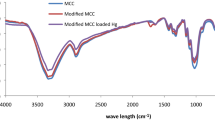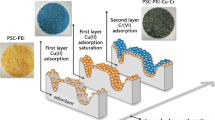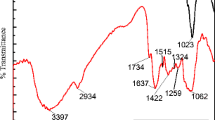Abstract
In this work, we incorporated Cu2+ on to microcrystalline cellulose (MCC) powder by a simple synthesis method to produce a composite material (Cu-MCC) with its suitability in prometryn (Pr) adsorption tested from synthetic wastewater. Various characterization techniques were applied in studying the prepared Cu-MCC with response surface methodology applied in order to study the influence of adsorbent dosage, solution pH and shaking speed, which suggested a quadratic model for the response (Pr percentage removal). The optimum adsorption conditions obtained were adsorbent dosage of 0.40 g, solution pH of 11 and shaking speed of 215 rpm with the model adequacy and significance validated by ANOVA. Langmuir and pseudo-second order were the most appropriate models in describing the generated equilibrium and kinetic data, giving rise to a monolayer adsorption capacity value of 97.80 mg/g at room temperature. The desorption of Pr on Cu-MCC was also probed depicting the adsorption capacity to be about 66.7% of its initial value after six sequential adsorption–desorption cycles. Overall, the prepared Cu-MCC was revealed to have great potential for being a good adsorbent in the removal of water contaminants such as Pr, based on the obtained results.
Graphic abstract











Similar content being viewed by others

References
Adetokun AA, Uba S, Garba ZN (2019) Optimization of adsorption of metal ions from a ternary aqueous solution with activated carbon from Acacia senegal (L.) Willd pods using Central Composite Design. J King Saud Univ Sci. https://doi.org/10.1016/j.jksus.2018.1012.1007
Afidah A, Garba ZN (2015) Optimization of preparation conditions for activated carbon from Prosopis africana seed hulls using response surface methodology. Desalin Water Treat 57:17985–17994
Ahmad MA, Alrozi R (2010a) Optimization of preparation conditions for mangosteen peel-based activated carbons for the removal of Remazol Brilliant Blue R using response surface methodology. Chem Eng J 165:883–890
Ahmad MA, Alrozi R (2010b) Removal of Malachite Green dye from aqueous solution using rambutan peel-based activated carbon: equilibrium, kinetic and thermodynamic studies. Chem Eng J 171:510–516
Akçay G, Akçay M, Yurdakoç K (2005) Removal of 2,4-dichlorophenoxyacetic acid from aqueous solutions by partially characterized organophilic sepiolite: thermodynamic and kinetic calculations. J Colloid Interface Sci 281:27–32
Akçay G, Akçay M, Yurdakoç K (2006) The characterization of prepared organomontmorillonite (DEDMAM) and sorption of phenoxyalkanoic acid herbicides from aqueous solution. J Colloid Interface Sci 296:428–433
Alidadi H, Dolatabadi M, Davoudi M, Barjasteh-Askari F, Jamali-Behnam F, Hosseinzadeh A (2018) Enhanced removal of tetracycline using modified sawdust: optimization, isotherm, kinetics, and regeneration studies. Proc Saf Environ Prot 117:51–60
Alidokht L, Khataee AR, Reyhanitabar A, Oustan S (2011) Cr(VI) immobilization process in a Cr-spiked soil by zerovalent iron nanoparticles: optimization using response surface methodology. CLEAN Soil Air Water 39:633–640
Alizadeh N, Shariati S, Besharati N (2017) Adsorption of Crystal Violet and Methylene Blue on azolla and fig leaves modified with magnetite iron oxide nanoparticles. Int J Environ Res 11:197–206
Aslam M, Gopakumar G, Shoba TL, Mulla IS, Vijayamohanan K, Kulkarni SK, Urban J, Vogel W (2002) Formation of Cu and Cu2O nanoparticles by variation of the surface ligand: preparation, structure, and insulating-to-metallic transition. J Colloid Interface Sci 255:79–90
Ayranci E, Hoda N (2005) Adsorption kinetics and isotherms of pesticides onto activated carbon-cloth. Chemosphere 60:1600–1607
Babic BM, Milonjic SK, Polovina MJ, Kaludierovic BV (1999) Point of zero charge and intrinsic equilibrium constants of activated carbon cloth. Carbon 37:477–481
Bartczak P, Żółtowska S, Norman M, Klapiszewski L, Zdarta J, Komosa A, Kitowski I, Ciesielczyk F, Jesionowski T (2016) Saw-sedge Cladium mariscus as a functional low-cost adsorbent for effective removal of 2,4-dichlorophenoxyacetic acid from aqueous systems. Adsorption 22:517–529
Bazrchi S, Bahram M, Nouri S (2018) Equilibrium and kinetic studies on the removal of acid red-14 from aqueous solutions using PSMA. Iran J Sci Technol Trans Sci 42:203–208
Bouamra F, Drouiche N, Abdi N, Grib H, Mameri N, Lounici H (2018) Removal of phosphate from wastewater by adsorption on marble waste: effect of process parameters and kinetic modeling. Int J Environ Res 12:13–27
Božič M, Liu P, Mathew AP, Kokol V (2014) Enzymatic phosphorylation of cellulose nanofibers to new highly-ions adsorbing, flame-retardant and hydroxyapatite-growth induced natural nanoparticles. Cellulose 21:2713–2726
Brillas E, Boye B, Baños MA, Calpe JC, Garrido JA (2003) Electrochemical degradation of chlorophenoxy and chlorobenzoic herbicides in acidic aqueous medium by theperoxi-coagulation method. Chemosphere 51:227–235
Brogan WR III, Relyea RA (2013) Mitigating with macrophytes: submersed plants reduce the toxicity of pesticide-contaminated water to zooplankton. Environ Toxicol Chem 32:699–707
Chuluun B, Iamchaturapatr J, Rhee JS (2009) Phytoremediation of organophosphorus and organochlorine pesticides by Acorus gramineus. Environ Eng Res 14:226–236
Das K, Ray D, Bandyopadhyay NR, Sengupta S (2010) Study of the properties of microcrystalline cellulose particles from different renewable resources by XRD, FTIR, nanoindentation, TGA and SEM. J Polym Environ 18:355–363
Deokar SK, Mandavgane SA, Kulkarni BD (2016) Adsorptive removal of 2,4 dichloro-phenoxyacetic acid from aqueous solution using bagasse fly ash as an adsorbent in batch and packed-bed techniques. Clean Technol Environ Policy 18:1971–1983
Fahma F, Iwamoto S, Hori N, Iwata T, Takemura A (2010) Isolation, preparation, and characterization of nanofibers from oil palm empty-fruit-bunch (OPEFB). Cellulose 17:977–985
French AD (2014) Idealized powder diffraction patterns for cellulose polymorphs. Cellulose 21:885–896
French AD, Santiago Cintrón M (2013) Cellulose polymorphy, crystallite size, and the Segal crystallinity index. Cellulose 20:583–588
Freundlich HMF (1906) Over the adsorption in solution. J Phys Chem 57:385–470
Garba ZN, Afidah AR (2014) Process optimization of K2C2O4-activated carbon from Prosopis africana seed hulls using response surface methodology. J Anal Appl Pyrol 107:306–312
Garba ZN, Afidah AR (2015) Optimization of activated carbon preparation conditions from Prosopis africana seed hulls for the removal of 2,4,6-trichlorophenol from aqueous solution. Desalin. Water Treat 56:2879–2889
Garba ZN, Afidah AR (2016) Evaluation of optimal activated carbon from an agricultural waste for the removal of para-chlorophenol and 2,4-dichlorophenol. Proc Saf Environ Prot 102:54–63
Garba ZN, Afidah AR, Bello BZ (2015) Optimization of preparation conditions for activated carbon from Brachystegia eurycoma seed hulls: a new precursor using central composite design. J Environ Chem Eng 3:2892–2899
Garba ZN, Bello I, Galadima A, Aisha YL (2016a) Optimization of adsorption conditions using central composite design for the removal of copper (II) and lead (II) by defatted papaya seed. Karbala Int J Mod Sci 2:20–28
Garba ZN, Ugbaga NI, Amina KA (2016b) Evaluation of optimum adsorption conditions for Ni(II) and Cd(II) removal from aqueous solution by modified plantain peels (MPP). Beni Suef Univ J Basic Appl Sci 5:170–179
Garba ZN, Hussin MH, Galadima A, Lawan I (2019) Potentials of Canarium schweinfurthii seed shell as a novel precursor for CH3COOK activated carbon: statistical optimization, equilibrium and kinetic studies. Appl Water Sci 9:1–13
Grabka D, Raczyńska-Żak M, Czech K, Słomkiewicz PM, Jóźwiak MA (2015) Modified halloysite as an adsorbent for prometryn from aqueous solutions. Appl Clay Sci 114:321–329
Gunny AAN, Arbain D, Jamal P (2017) Effect of structural changes of lignocelluloses material upon pre-treatment using green solvents. In: AIP conference proceedings. https://doi.org/10.1063/1061.4981844
Gurnani V, Singh AK (2004) Equilibrium studies on the optimization of solid-phase extraction of metal ions with pyrogallol-anchored cellulose synthesized by a new method and applications of the extraction in metal enrichment, removal and determination. Ind Eng Chem Res 43:2302–2309
Hamad H, Bailón-García E, Morales-Torres S, Carrasco-Marín F, Pérez-Cadenas AF, Maldonado-Hódar FJ (2018) Physicochemical properties of new cellulose-TiO2 composites for the removal of water pollutants: developing specific interactions and performances by cellulose functionalization. J Environ Chem Eng 6:5032–5041
Hameed BH, Tan IA, Ahmad AL (2009) Preparation of oil palm empty fruit bunch-based activated carbon for removal of 2,4,6-trichlorophenol: optimization using response surface methodology. J Hazard Mater 164:1316–1324
Hashem A, El-Shishtawy RM (2001) Preparation and characterization of cationized cellulose for the removal of anionic dyes. Adsorp Sci Technol 19:197–210
Hernandez RB, Yola OR, Merce ALR (2007) Chemical equilibrium in the complexation of first transition series divalent cations Cu2+, Mn2+ and Zn2+ with chitosan. J Braz Chem Soc 18:1388–1396
Hladik ML, Roberts AL, Bouwer EJ (2005) Removal of neutral chloroacetamide herbicide degradates during simulated unit processes for drinking water treatment. Water Resour 39:5033–5044
Hu D, Wang P, Li J, Wang L (2014) Functionalization of microcrystalline cellulose with n,n-dimethyldodecylamine for the removal of Congo Red dye from an aqueous solution. BioResources 9:5951–5962
Hussin MH, Pohan NA, Garba ZN, Kassim MJ, Afidah AR, Brosse N, Yemloul M, Fazita MRN, Haafiz MKM (2016) Physicochemical of microcrystalline cellulose from oil palm fronds aspotential methylene blue adsorbents. Int J Biol Macromol 92:11–19
Islam MA, Sabar S, Benhouria A, Khanday WA, Asif M, Hameed BH (2017) Nanoporous activated carbon prepared from karanj (Pongamia pinnata) fruit hulls for methylene blue adsorption. J Taiwan Inst Chem Eng 74:96–104
Jawad AH, Abd Rashid R, Mahmuod RMA, Ishak MAM, Kasim NN, Ismail K (2015) Adsorption of methylene blue onto coconut (Cocos nucifera) leaf: optimization, isotherm and kinetic studies. Desalin Water Treat 57:8839–8853
Jawad AH, Ishak MAM, Farhan AM, Ismail K (2017) Response surface methodology approach for optimization of color removal and COD reduction of methylene blue using microwave-induced NaOH activated carbon from biomass waste. Desalin Water Treat 62:208–220
Jiao C, Tao J, Xiong J, Wang X, Zhang D, Lin H, Chen Y (2017) In situ synthesis of MnO2-loaded biocomposite based on microcrystalline cellulose for Pb2+ removal from wastewater. Cellulose 24:2591–2604
Jinbao L, Huijuan X, Meiyun Z, Hai W, Yangyu R, Yun J (2013) Enhancement of cellulose acid hydrolysis selectivity usingmetal ion catalysts. Curr Org Chem 17:1617–1623
Jorgetto AO, Silva RIV, Longo MM, Saeki MJ, Padilha PM, Martines MAU, Rocha BP, Castro GR (2013) Incorporation of dithiooxamide as a complexing agent into cellulose for the removal and pre-concentration of Cu(II) and Cd(II) ions from natural water samples. Appl Surf Sci 264:368–374
Kanissery RG, Sims GK (2011) Biostimulation for the enhanced degradation of herbicides in soil Appl. Environ. Soil Sci. 2011, 843450. http://dx.doi.org/10.1155/2011/843450
Krutz LJ, Sensemana SA, Dozierb MC, Hoffmanc DW, Tierney DP (2003) Infiltration and adsorption of dissolved atrazine and atrazine metabolites in buffalograss filter strips JEQ 32:2319–2324
Langmuir I (1918) The adsorption of gases on plane surfaces of glass, mica and platinum. J Am Chem Soc 40:1361–1403
Liu J, Pan D, Wu X, Chen H, Cao H, Li QX, Hua R (2018) Enhanced degradation of prometryn and other s-triazine herbicides in pure cultures and wastewater by polyvinyl alcohol-sodium alginate immobilized Leucobacter sp. JW-1. Sci Total Environ 615:78–86
Lu Q, Tang L, Lin F, Wang S, Chen Y, Chen X, Huang B (2014) Preparation and characterization of cellulose nanocrystals via ultrasonication-assisted FeCl3-catalyzed hydrolysis. Cellulose 21:3497–3506
Martins AC, Pezoti O, Cazetta AL, Bedin KC, Yamazaki DAS, Bandoch GFG, Asefa T, Visentainer JV, Almeida VC (2015) Removal of tetracycline by NaOH-activated carbon produced from macadamia nut shells: kinetic and equilibrium studies. Chem Eng J 260:291–299
Matby L, Arnold D, Arts G, Davies J, Haimbach F, Pickl C, Polusen V (2009) Aquatic macrophyte risk assessment for pesticides, 1st edn. CRC Press, Boca Raton
Miao C, Hamad WY (2013) Cellulose reinforced polymer composites and nanocomposites: a critical review. Cellulose 20:2221–2262
Mohammad A-T, Abdulhameed AS, Jawad AH (2019) Box-Behnken design to optimize the synthesis of new crosslinked chitosan-glyoxal/TiO2 nanocomposite: methylene orange adsorption and mechanism studies. Int J Biol Macromol 129:98–109
Nawaz K, Hussain K, Choudary N, Majeed A, Ilyas U, Ghani A, Lin F, Ali K, Afghan S, Raza G, Lashari MI (2011) Eco-friendly role of biodegradation against agricultural pesticides hazards. Afr J Microbiol Res 5:177–183
Njoku VO, Islam MA, Asif M, Hameed BH (2014) Preparation of mesoporous activated carbon from coconut frond for the adsorption of Carbofuran insecticide. J Anal Appl Pyrol 110:172–180
Okumus V, Celik KS, Ozdemir S, Dundar A, Kilinc E (2015) Biosorption of chlorophenoxy acid herbicides from aqueous solution by using low-cost agricultural wastes. Desalin Water Treat 56:1898–1907
Park Y, Ayoko GA, Frost RL (2011) Application of organoclays for the adsorption of recalcitrant organic molecules from aqueous media. J Colloid Interface Sci 354:292–305
Pelosi BT, Lima LKS, Vieira MGA (2014) Removal of the synthetic dye Remazol Brilliant Blue R from textile industry wastewaters by biosorption on the macrophyte Salvinia natans. Braz J Chem Eng 31:1035–1045
Peña A, Palma R, Mingorance MD (2011) Transport of dimethoate through a Mediterranean soil under flowing surfactant solutions and treated wastewater. Coll Surf A Physicochem Eng Aspects 384:507–512
Plakas KV, Karabelas AJ (2009) Triazine retention by nanofiltration in the presence of organic matter: the role of humic substance characteristics. J Membr Sci 336:86–100
Pyrzynska K (2011) Carbon nanotubes as sorbents in the analysis of pesticides. Chemosphere 83:1407–1413
Pyrzynska K, Stafiej A, Biesaga M (2007) Sorption behavior of acidic herbicides on carbon nanotubes. Microchim Acta 159:293–298
Ren L, ZhangJ Li Y, Zhang C (2011) Preparation and evaluation of cattail fiber-based activated carbon for 2,4-dichlorophenol and 2,4,6-trichlorophenol removal. Chem Eng J 168:553–561
Salman JM, Hameed BH (2010a) Adsorption of 2,4-dichlorophenoxyacetic acid and Carbofuran pesticides onto granular activated carbon. Desalin 256:129–135
Salman JM, Hameed BH (2010b) Removal of insecticide carbofuran from aqueous solutions by banana stalks activated carbon. J Hazard Mater 176:814–819
Salman JM, Njoku VO, Hameed BH (2011) Bentazon and carbofuran adsorption onto date seed activated carbon: kinetics and equilibrium. Chem Eng J 173:361–368
Scribner EA, Thurman EM, Goolsby DA, Meyer MT, Battaglin, WA, Kolpin D.W.S.I.R., U.S. Geological Survey, Reston, Virginia (2005) Summary of significant results from studies of triazine herbicides and their degradation products in surface water, ground water, and precipitation in the midwestern United States during the 1990s. Scientific Investigations Report U.S. Geological Survey, Reston, Virginia
Silva LS, Lima LCB, Silva FC, Matos JME, Santos MRMC, Santos Júnior LS, Sousa KS, da Silva Filho EC (2013) Dye anionic sorption in aqueous solution onto a cellulose surface chemically modified with aminoethanethiol. Chem Eng J 218:89–98
Sun C, Huang Z, Wang J, Rao L, Zhang J, Yu J, Du J, Xu C (2016) Modification of microcrystalline cellulose with pyridone derivatives for removal of cationic dyes from aqueous solutions. Cellulose 23:2917–2927
Tan CHC, Sabar S, Hussin MH (2018) Development of immobilized microcrystalline cellulose as an effective adsorbent for methylene blue dye removal. S Afr J Chem Eng 26:11–24
Trache D, Hussin MH, Hui Chuin CT, Sabar S, Fazita MRN, Taiwo OFA (2016) Microcrystalline cellulose: isolation, characterization and bio-composites application—a review. Int J Biol Macromol 93:789–804
Velisek J, Stara A, Koutnik D, Machova J (2015) Effects of Prometryn on early life stages of common carp (Cyprinus carpio L.). Pestic Biochem Physiol 118:58–63
Vieira Ferreira LF, Ferreira DP, Duarte P, Oliveira A, Torres E, Ferreira Machado I, Almeida P, Reis LV, Santos PF (2012) Surface photochemistry: 3,3′-dialkylthia and selenocarbocyanine dyes adsorbed onto microcrystalline cellulose. Int J Mol Sci 13:596–611
Yonli AH, Batonneau-Gener I, Koulidiati J (2012) Adsorptive removal of α-endosulfan from water by hydrophobic zeolites. An isothermal study. J Hazard Mater 203:357–362
Zhou JH, Hu F, Jiao JG, Liu MQ, Li HX (2012) Effects of bacterial-feeding nematodes and prometryne-degrading bacteria on the dissipation of Prometryn in contaminated soil. J Soils Sedim 12:576–585
Acknowledgments
The authors would like to humbly acknowledge the international funding provided by Fujian Agriculture and Forestry University (KXB16001A) PR China.
Author information
Authors and Affiliations
Corresponding author
Ethics declarations
Conflict of interest
The authors have no conflict of interest with regards to the submission and publication of this article.
Additional information
Publisher's Note
Springer Nature remains neutral with regard to jurisdictional claims in published maps and institutional affiliations.
Electronic supplementary material
Below is the link to the electronic supplementary material.
Rights and permissions
About this article
Cite this article
Garba, Z.N., Zhou, W., Lawan, I. et al. Enhanced removal of prometryn using copper modified microcrystalline cellulose (Cu-MCC): optimization, isotherm, kinetics and regeneration studies. Cellulose 26, 6241–6258 (2019). https://doi.org/10.1007/s10570-019-02531-9
Received:
Accepted:
Published:
Issue Date:
DOI: https://doi.org/10.1007/s10570-019-02531-9



